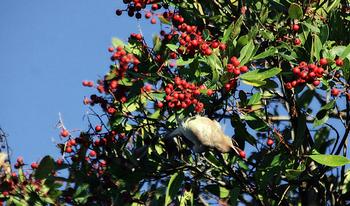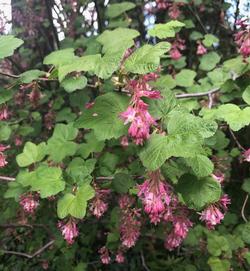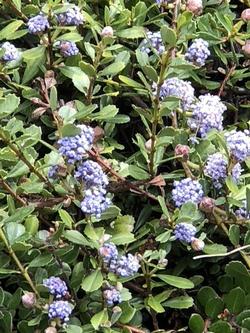Fall 2023
Plant Native Shrubs Now for Winter and Spring Bloom
by Laurinda Ochoa
Fall is the ideal time to plant California natives and other Mediterranean plants that grow with our winter rains and bloom in late winter and spring. Planting now gives the roots of these plants time to grow into the soil and become established before the high temperatures and dry climate of our summers.
In past articles, we’ve talked about California native perennials and annuals (see References at the end of this article). Many county gardeners also ask, which native shrubs can we plant that thrive here in Contra Costa County?
Shrubs are multi-branched plants that are smaller than trees and larger than bushes. Shrubs are long-lived perennial woody plants that can be either evergreen or deciduous (lose their leaves). Although not as long-lived as multi-century-old trees, most native shrubs can live for decades both in nature and in our gardens, compared to commercial, hybridized, and non-native shrubs, which generally need to be replaced more frequently than native shrubs.
There are many beautiful shrubs that fit well in home gardens. Here are some that provide valuable habitats for birds and insects and bring beauty into our lives, such as:
- Toyon
- Manzanitas
- Ribes
- Ceanothus
Quick Tip: Go to Calscape, a native plant database from the California Native Plant Society. Type in your zip code and find the best plants, trees, and shrubs for all your garden conditions.
Toyon

Toyons are considered easy to grow and often propagate naturally by seed. They thrive in a variety of soils, including our heavy clay soil, serpentine, and sand. They like full sun along the coast and partial shade in the hotter parts of California. Although Toyon are drought-resistant, they can tolerate more summer water in the garden than many natives.
Toyon is a fire-retardant plant when watered well and can be planted as a hedge or near homes. It has deep roots and can be used for soil stabilization and erosion control. In the right locations, these shrubs can reach 10–15 feet in width, so plan ahead when placing them in your garden. If they get too large or leggy, Toyon can be pruned back to the ground and will regrow from the base.
Unlike Pyracantha, another common but non-native shrub that has seasonal red berries that attract birds, Toyon does not have spines. A beautiful habitat plant that provides color for humans and food and shelter for birds and small mammals, Toyon is an excellent addition to our gardens.
Manzanitas

Manzanitas include over 90 varieties that are native to California and range in size from ground covers of 2-3 inches in height to large shrubs (and small trees) up to 20 feet tall. With their evergreen leaves and small pinkish and white flowers, manzanitas are one of the first plants to flower in the winter and are important nectar and pollen sources for our native hummingbirds and bees.
Manzanitas are beautiful and easy-to-grow shrubs that are now available in many nurseries. Although manzanitas will need regular watering to become established, once their roots are established, they grow quickly and can survive without any summer water, even in our hot interior valleys. Some experts advise that established Manzanita, especially those planted in heavy clay soils, not be watered in the summer months due to the increasing prevalence of the phytophthora virus, which is the virus associated with sudden oak death in our natural environment.
As with all native plants, it’s recommended that gardeners research their location, soil type, and sun exposure on Calscape to find the best Manzanitas for their gardens. There are coastal forms that enjoy the extra moisture and cooling fogs from the San Francisco Bay and interior forms that prefer dry, sandy soils. All manzanitas seem to prefer good drainage, so it is important not to overwater them in the summer when they are planted in heavy clay.
Ribes

Native to our area, Ribes’ delicately scented flowers appear after our winter rains and can be a creamy-yellow, a more common light pink, or the brighter pinkish-red of our local Ribes sanguineum ‘Claremont’. These hummingbird- and butterfly-attracting flowers appear in early spring on short racemes (multiple flowers attached on short stalks to a central stem) with up to 2–3 dozen small flowers that hang down and swing in the spring breezes. The small, dark fruits are eaten by birds.
Ribes grow best in light shade in our inland areas and can tolerate full sun near the coast. They are tolerant of most soil types and are considered easy-to-grow plants in most home gardens. They make an excellent spring-flowering specimen plant in a small garden and can be pruned back and shaped after blooming.
Ceanothus

Ceanothus grows best in full sun and needs good drainage to thrive. They can be long-lived native shrubs but will not survive with typical summer garden watering after they become established, so it is important to plant them away from lawns and other garden areas that receive regular watering. Like Manzanita, Ceanothus will survive in full sun without any summer water.
In areas where deer are a problem, Ceanothus will be less appetizing when they are a little drier and not watered during the summer months. While they are being established and watered, it is important to protect them from hungry deer.
Summary
With these easy-to-grow and readily available California shrubs, anyone can enjoy the beauty and habitat value of our native flora next spring. Many people like to add some of the many native wildflowers, such as Lupine, Tidy Tips, Clarkias, and California poppies. Now is the best time to sow wildflower seeds so they can germinate and grow with our winter rains and cooler temperatures. Sowing wildflower seeds now will guarantee your own spring wildflower bloom in 2024.
Happy Fall Gardening!
References
Native Plant Gardening in the Spring
News to Grow By, Spring 2023
Now Is the Time to Plant Natives in Your Garden!
News to Grow By, Winter 2023
Fall is a Great Time to Plant
News to Grow By, Fall 2022
Fall is a great time to plant drought tolerant plants
News to Grow By, Fall 2021
Fall is the best time to plant California native plants
News to Grow By, Fall 2020
